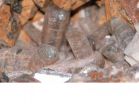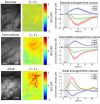(Press-News.org) Exactly how a crystal forms from solution is a problem that has occupied scientists for decades. Researchers at Eindhoven University of Technology (TU/e), together with researchers from Germany and the USA, are now presenting the missing piece. This classical theory of crystal formation, which occurs widely in nature and in the chemical industry, was under fire for some years, but is saved now. The team made this breakthrough by detailed study of the crystallization of the mineral calcium phosphate –the major component of our bones. The team published their findings yesterday in the online journal Nature Communications.
Crystallization is the formation of a solid ordered substance, such as happens when water freezes. In nature, crystals are mostly formed from ions which are dissolved in water, as for example in the formation of shells or bone. This involves the clustering of ions into increasingly large nuclei, until a crystal is formed when a certain size is reached. However, the details of this growth process have been the subject of discussion for many years.
According to the existing theories, it is individual ions that group together to form crystal nuclei. But in 2009 chemists led by dr. Nico Sommerdijk (TU/e) showed the presence of an intermediate step in the growth process of calcium carbonate crystals. The ions were thought to first form small clusters, which then grow into crystal nuclei. This finding, which was the cover story of Science, caused controversy because it appeared to contradict the classical crystallization theories which did not allow for such an intermediate step.
Now Sommerdijk is having second thoughts about his 2009 conclusions. At least, the answer now turns out to be more subtle than was thought at that time. Together with researchers from the Max Planck Institute in Germany and the Lawrence Berkeley National Laboratory in the USA, he looked more closely at the role of these so-called pre-nucleation clusters in the growth process of the mineral calcium phosphate. Using a cryo-electron microscope, which makes images of deep-frozen samples, he was able to identify the precise components of the clusters and study the growth process in detail.
In their article in Nature Communications Sommerdijk concludes that the clusters do not form a clearly defined intermediate step, but instead are part of a gradual growth process. Sommerdijk refers to the formation of clusters as a 'false start' by the ions, because the clusters already start to organize themselves step by step while still in solution, without actually forming growth nuclei. This new understanding means the existing theories no longer need to be overturned. Sommerdijk's team now complete the theory by describing alternative 'pathways' along which crystals can form. Sommerdijk's new conclusions have since been confirmed in a second study into crystal formation in the mineral magnetite, which was published online this month in Nature Materials.
In recent years both the role and the composition of the pre-nucleation clusters were the subject of intense scientific discussions, for example last summer during the prestigious Faraday Discussions. There were also disagreements within the team itself about Sommerdijk's new interpretation. Some team members held onto the original scenario, even after numerous new experiments had confirmed that the clusters did not have the same composition and role as believed earlier. Finally it was decided to submit the article, which after four years of experimenting and revision had reached a final length of almost 100 pages, without the names of the team members who were unable to accept the new ideas.
In Sommerdijk's view the most important questions about the formation of crystals have now been answered. This theoretical knowledge is important in many fields, because of the widespread occurrence of crystallization in nature and in the chemical industry. Just a few examples are the formation of coral in the sea, the production of pharmaceuticals and the design of nanoparticles. It could for example help to make production processes less costly, faster or more energy-efficient.
INFORMATION:
The article 'Ion-association complexes unite classical and non-classical theories for the biomimetic nucleation of calcium phosphate' will be published on 19 February in Nature Communications, DOI 10.1038/ncomms2490.
The article 'Nucleation and growth of magnetite from solution', to which Nico Sommerdijk also contributed, was published online on 3 February in Nature Materials, DOI 10.1038/nmat3558.
Theory of crystal formation complete again
2013-02-19
ELSE PRESS RELEASES FROM THIS DATE:
New study shows how seals sleep with only half their brain at a time
2013-02-19
TORONTO, ON – A new study led by an international team of biologists has identified some of the brain chemicals that allow seals to sleep with half of their brain at a time.
The study was published this month in the Journal of Neuroscience and was headed by scientists at UCLA and the University of Toronto. It identified the chemical cues that allow the seal brain to remain half awake and asleep. Findings from this study may explain the biological mechanisms that enable the brain to remain alert during waking hours and go off-line during sleep.
"Seals do something biologically ...
We know when we're being lazy thinkers
2013-02-19
Are we intellectually lazy? Yes we are, but we do know when we take the easy way out, according to a new study by Wim De Neys and colleagues, from the CNRS in France. Contrary to what psychologists believe, we are aware that we occasionally answer easier questions rather than the more complex ones we were asked, and we are also less confident about our answers when we do. The work is published online in Springer's journal Psychonomic Bulletin & Review.
Research to date on human thinking suggests that our judgment is often biased because we are intellectually lazy, or ...
NYU's Shedlin publishes study on the health of Colombian refugees in Ecuador
2013-02-19
New York University College of Nursing's Professor Michele Shedlin, PhD, recently published a paper, "Sending-Country Violence and Receiving-Country Discrimination: Effects on the Health of Colombian Refugees in Ecuador," on-line in the Journal of Immigrant and Minority Health, February 2, 2013.
Studies of immigrant health have historically focused on individual-level risk factors more than environmental/structural factors as salient mediating variables. Shedlin's research addresses the need to reach a more complete understanding of the migration process and vulnerabilities ...
Study shows that diet of resistant starch helps the body resist colorectal cancer
2013-02-19
As the name suggests, you can't digest resistant starch so it ends up in the bowel in pretty much the same form it entered your mouth. As unlovely as that seems, once in the bowel this resistant starch does some important things, including decreasing bowel pH and transit time, and increasing the production of short-chain fatty acids. These effects promote the growth of good bugs while keeping bad bugs at bay. A University of Colorado Cancer Center review published in this month's issue of the journal Current Opinion in Gastroenterology shows that resistant starch also helps ...
Annals of Internal Medicine tip sheet for Feb. 19, 2013
2013-02-19
1. Acupuncture May be an Effective Alternative for Treating Seasonal Allergies
Patients receiving acupuncture treatments for seasonal allergic rhinitis reported statistically significant improvements in symptoms and decreased use of medication compared to patients having standard treatment or sham acupuncture, but the clinical significance of the observed improvements is uncertain. Allergic rhinitis (stuffy or runny nose caused by allergies) is an extremely common condition that affects approximately 20 percent of the U.S. population. Despite the availability of effective ...
Shedding new light on infant brain development
2013-02-19
New York, NY—February 18, 2013—A new study by Columbia Engineering researchers finds that the infant brain does not control its blood flow in the same way as the adult brain. The paper, which the scientists say could change the way researchers study brain development in infants and children, is published in the February 18 Early Online edition of Proceedings of the National Academy of Sciences (PNAS).
"The control of blood flow in the brain is very important" says Elizabeth Hillman, associate professor of Biomedical Engineering and of Radiology, who led the research study ...
The role of goop: Research shows pollution doesn't change the rate of droplet formation
2013-02-19
When it comes to forming the droplets that make up clouds, a little oily and viscous organic material apparently doesn't matter that much. And that's good news for reducing the uncertainty of climate model predictions.
Understanding cloud formation is essential for accurate climate modeling, and understanding cloud formation begins with the droplets that make up clouds. Droplets form when water vapor is attracted to particles floating in the atmosphere. These particles include dust, sea salt from the ocean, microorganisms, soot, sulfur – and organic material that can ...
Study suggests women have higher risk of hip implant failure
2013-02-19
Women appear to have a higher risk of implant failure than men following total hip replacement after considering patient-, surgery-, surgeon-, volume- and implant-specific risk factors, according to a report published Online First by JAMA Internal Medicine, a JAMA Network publication.
Total hip replacement, also known as total hip arthroplasty (THA), is more often performed in women than men. Sex-specific risk factors and outcomes have been investigated in other major surgical procedures and, in theory, might be more important to study in THA because of anatomical differences ...
Study suggests reduced lung function in infancy associated with wheeze later
2013-02-19
A study in Australia suggests that reduced lung function in infancy was associated with wheezing beyond childhood at 18 years of age, according to a report published Online First by JAMA Pediatrics, a JAMA Network publication.
Abnormal airway function is characteristic of asthma and chronic obstructive airways disease, and other studies have suggested that reduced lung function is already apparent in childhood and tracks through adulthood. However, the relationship between the age of onset of airway dysfunction and wheeze, a symptom of obstructive airways disease, has ...
A solution to sinusitis from the sea
2013-02-19
A team of scientists and surgeons from Newcastle are developing a new nasal spray from a marine microbe to help clear chronic sinusitis.
They are using an enzyme isolated from a marine bacterium Bacillus licheniformis found on the surface of seaweed which the scientists at Newcastle University were originally researching for the purpose of cleaning the hulls of ships.
Publishing in PLOS ONE, they describe how in many cases of chronic sinusitis the bacteria form a biofilm, a slimy protective barrier which can protect them from sprays or antibiotics. In vitro experiments ...

